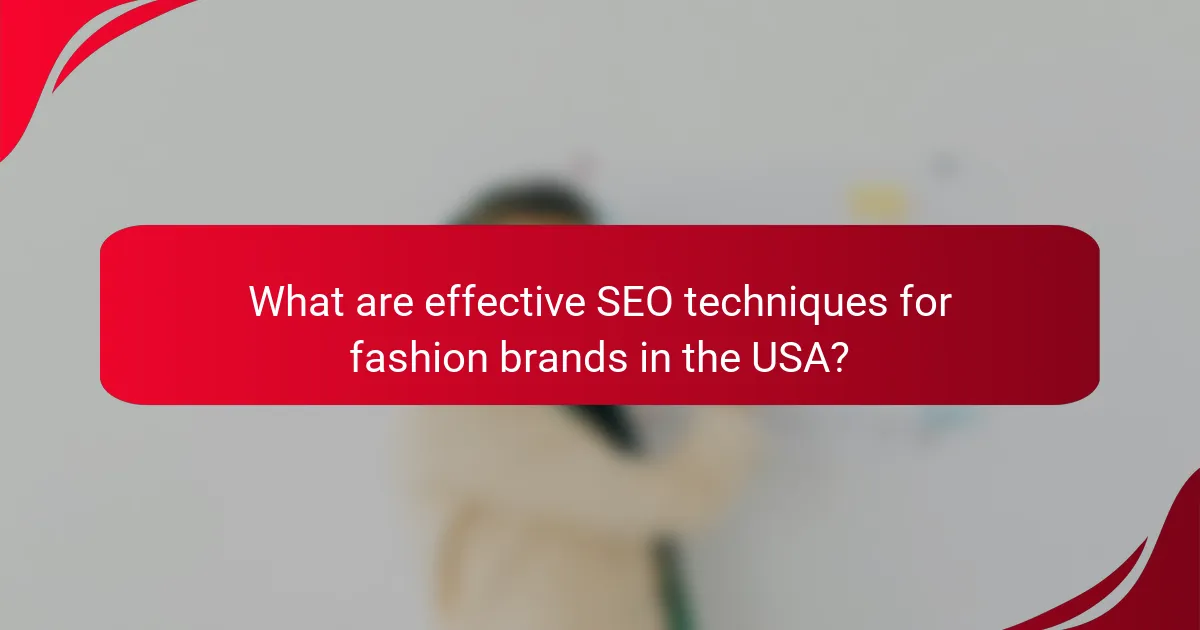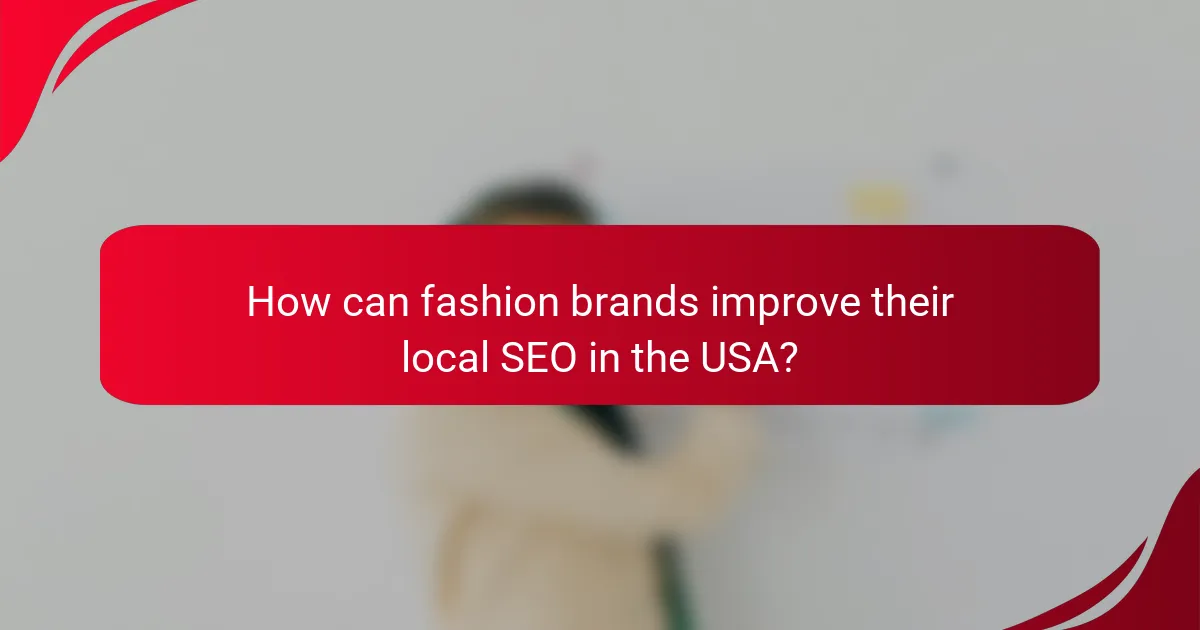In the competitive landscape of the USA’s fashion market, implementing effective SEO techniques is crucial for brands aiming to enhance their online presence. By focusing on keyword optimization, content marketing, and local SEO strategies, fashion brands can improve their visibility in search engines and attract targeted traffic. Additionally, leveraging social media platforms can further boost brand visibility and engagement, driving sales and fostering customer loyalty.

What are effective SEO techniques for fashion brands in the USA?
Effective SEO techniques for fashion brands in the USA involve a combination of keyword optimization, content marketing, on-page SEO, technical SEO, and link building. These strategies help improve visibility in search engines, attract targeted traffic, and ultimately drive sales.
Keyword optimization strategies
Keyword optimization is crucial for fashion brands to rank higher in search results. Start by researching relevant keywords that potential customers use when searching for fashion products, focusing on long-tail keywords that reflect specific styles or trends.
Utilize tools like Google Keyword Planner or SEMrush to identify high-volume keywords with manageable competition. Incorporate these keywords naturally into product descriptions, blog posts, and meta tags to enhance search visibility.
Content marketing approaches
Content marketing is an effective way to engage your audience and establish brand authority. Create high-quality blog posts, style guides, and lookbooks that resonate with your target demographic, showcasing your products in practical contexts.
Consider using video content, such as styling tutorials or behind-the-scenes footage, to further engage users. Share this content across social media platforms to drive traffic back to your website and improve SEO through increased user interaction.
On-page SEO best practices
On-page SEO focuses on optimizing individual web pages to rank higher and earn more relevant traffic. Ensure that each page has a unique title tag and meta description that includes primary keywords, accurately reflecting the content.
Use header tags (H1, H2, H3) to structure content clearly, and optimize images with descriptive alt text. Aim for a clean URL structure that includes keywords and is easy to read, enhancing both user experience and search engine indexing.
Technical SEO considerations
Technical SEO ensures that your website is accessible and easy to navigate for search engines. Focus on improving site speed, as slow-loading pages can lead to higher bounce rates and lower rankings. Aim for a load time of under three seconds.
Implement mobile optimization to cater to the growing number of users shopping on smartphones. Regularly check for broken links, duplicate content, and ensure that your website is secure with HTTPS to enhance trustworthiness.
Link building tactics
Link building is essential for increasing domain authority and improving search rankings. Focus on acquiring high-quality backlinks from reputable fashion blogs, influencers, and industry websites. Guest posting and collaborations can be effective ways to earn these links.
Engage in local SEO by getting listed in local directories and fashion-related platforms. Participate in community events or sponsorships to gain exposure and backlinks from local news outlets or blogs, which can significantly boost your local search visibility.

How can fashion brands improve their local SEO in the USA?
Fashion brands can enhance their local SEO in the USA by focusing on strategies that increase visibility in local search results. Key techniques include optimizing Google My Business listings, targeting local keywords, and encouraging customer reviews.
Google My Business optimization
Optimizing your Google My Business (GMB) listing is crucial for local SEO. Ensure that your business name, address, and phone number (NAP) are accurate and consistent across all platforms. Add high-quality images of your products and store, and keep your business hours updated.
Utilize GMB features like posts and Q&A to engage with customers and provide timely information. This not only improves your visibility but also enhances customer interaction, making your brand more appealing in local searches.
Local keyword targeting
Targeting local keywords involves incorporating location-specific terms into your website content. Use tools like Google Keyword Planner to find relevant keywords that potential customers might use, such as “women’s clothing in New York” or “men’s shoes Los Angeles.”
Integrate these keywords naturally into your product descriptions, blog posts, and meta tags. This helps search engines understand your relevance to local queries and can significantly boost your rankings in local search results.
Customer reviews and ratings
Customer reviews and ratings play a vital role in local SEO and can influence potential buyers. Encourage satisfied customers to leave positive reviews on your GMB listing and other platforms like Yelp or Facebook. Aim for a steady stream of reviews to keep your business active and visible.
Responding to reviews, both positive and negative, shows that you value customer feedback. This engagement can improve your brand’s reputation and encourage more customers to choose your business over competitors.

What role does social media play in fashion brand SEO?
Social media significantly enhances fashion brand SEO by driving traffic, increasing brand visibility, and improving search engine rankings. Engaging content on platforms like Instagram and TikTok can lead to higher user interaction, which search engines recognize as a positive signal.
Influencer collaborations
Collaborating with influencers can amplify a fashion brand’s reach and credibility. Influencers often have dedicated followings that trust their recommendations, making them effective partners for promoting products. Brands should seek influencers whose audience aligns with their target market to maximize impact.
When selecting influencers, consider their engagement rates and authenticity. A smaller influencer with a highly engaged audience may yield better results than a larger influencer with lower interaction. Establish clear goals for the collaboration to measure its effectiveness.
Social media content strategies
Effective content strategies on social media should focus on high-quality visuals and storytelling that resonate with the audience. Fashion brands can showcase their products through lookbooks, behind-the-scenes content, and user-generated posts to create a community around their brand.
Utilizing a mix of content types, such as videos, reels, and carousel posts, can keep the audience engaged. Regularly posting and interacting with followers can also enhance visibility and foster loyalty, which are crucial for SEO performance.
Engagement metrics impact
Engagement metrics, such as likes, shares, and comments, play a vital role in determining a brand’s visibility on social media. Higher engagement signals to algorithms that content is valuable, which can lead to increased exposure and traffic to the brand’s website.
Brands should track these metrics to understand what content resonates best with their audience. Adjusting strategies based on engagement data can help refine future campaigns and improve overall SEO outcomes. Regularly analyzing performance can guide brands in optimizing their social media presence effectively.

What are the key metrics for measuring SEO success?
Key metrics for measuring SEO success include organic traffic, conversion rates, and search engine rankings. These metrics provide insights into how well a website is performing in search engines and its effectiveness in converting visitors into customers.
Organic traffic analysis
Organic traffic analysis involves tracking the number of visitors coming to your site through unpaid search results. Tools like Google Analytics can help you monitor traffic sources, allowing you to identify which keywords and content are driving the most visitors.
To effectively analyze organic traffic, focus on trends over time rather than daily fluctuations. A steady increase in organic traffic indicates successful SEO efforts, while sudden drops may signal issues that need addressing.
Conversion rates tracking
Conversion rates tracking measures the percentage of visitors who complete a desired action, such as making a purchase or signing up for a newsletter. This metric is crucial for understanding the effectiveness of your SEO strategy in generating leads or sales.
To improve conversion rates, consider optimizing landing pages and ensuring that calls-to-action are clear and compelling. A typical conversion rate for e-commerce sites in the USA might range from 1% to 3%, but this can vary based on industry and target audience.
Search engine rankings monitoring
Search engine rankings monitoring tracks where your website appears in search results for specific keywords. Regularly checking these rankings helps you assess the effectiveness of your SEO tactics and identify areas for improvement.
Utilize tools like SEMrush or Ahrefs to monitor keyword rankings. Aim to rank on the first page of search results for relevant keywords, as most clicks go to the top three positions. Adjust your SEO strategy based on ranking changes to maintain or improve visibility.

How can fashion brands stay competitive in SEO?
Fashion brands can maintain competitiveness in SEO by focusing on targeted keyword strategies, optimizing their website structure, and enhancing user experience. Staying informed about industry trends and consumer behavior is crucial for adapting to the ever-changing digital landscape.
Competitor analysis techniques
Conducting a thorough competitor analysis helps fashion brands identify strengths and weaknesses in their SEO strategies. Start by examining competitors’ keyword usage, backlink profiles, and content strategies. Tools like SEMrush or Ahrefs can provide insights into which keywords drive traffic to their sites.
Additionally, analyze competitors’ social media presence and customer engagement. Understanding how they interact with their audience can inform your own strategies. Look for gaps in their offerings that you can exploit to attract more visitors.
Adapting to algorithm changes
Fashion brands must stay agile in response to search engine algorithm updates to maintain their rankings. Regularly reviewing SEO practices and staying informed about major updates from Google can help brands adjust their strategies accordingly. For instance, focusing on quality content and user experience is often a safe bet.
Implementing structured data can enhance visibility in search results, especially for product listings. Brands should also monitor their website analytics to identify any drops in traffic that may indicate a need for strategy adjustments. Regular audits can help ensure compliance with the latest SEO best practices.










